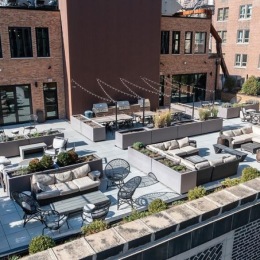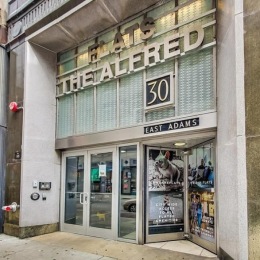Finding Rentals That Welcome Cats Without the Cat-astrophe
Finding the Purr-fect Place: Cat Friendly Rentals Guide
Looking for cat friendly rentals? Here's what you need to know:
- Georgia has the highest percentage of cat-friendly rentals (70.7%)
- Jacksonville, FL leads cities with 83.3% of rentals allowing cats
- Only 15 states have more cat-friendly than dog-friendly rentals
- The Northeast region tends to be more accepting of cats than dogs
- Most rentals require a pet deposit and may have limits on number of cats
- Pet resumes with vet references can improve approval chances
Finding cat friendly rentals can feel like a challenging quest for the millions of Americans who consider their feline companions family members. The pandemic pet adoption boom coupled with rising rent costs has created a perfect storm for cat owners seeking new homes.
When you're moving with a cat, the search requires more than just finding a place that allows pets. You need a home that accommodates your feline friend's needs while meeting landlord requirements.
According to research, Georgia stands out as the most cat-friendly state, with over 70% of rentals welcoming cats. In contrast, cities like San Jose show a strong preference for dogs, with an 84:16 ratio favoring canine companions.
The good news? Cats are often viewed as more "apartment-friendly" than dogs. They don't require outdoor walks, tend to be quieter, and generally cause less property damage than their canine counterparts.
Why landlords might prefer cats:
- Lower noise levels (no barking)
- No need for outdoor bathroom breaks
- Independent nature requires less supervision
- Typically smaller and less likely to damage property structurally
Understanding what makes rentals truly "cat-friendly" versus merely "pet-tolerant" is the first step in finding your ideal home. The right approach can transform your housing search from a frustrating experience into a successful transition for both you and your feline family member.
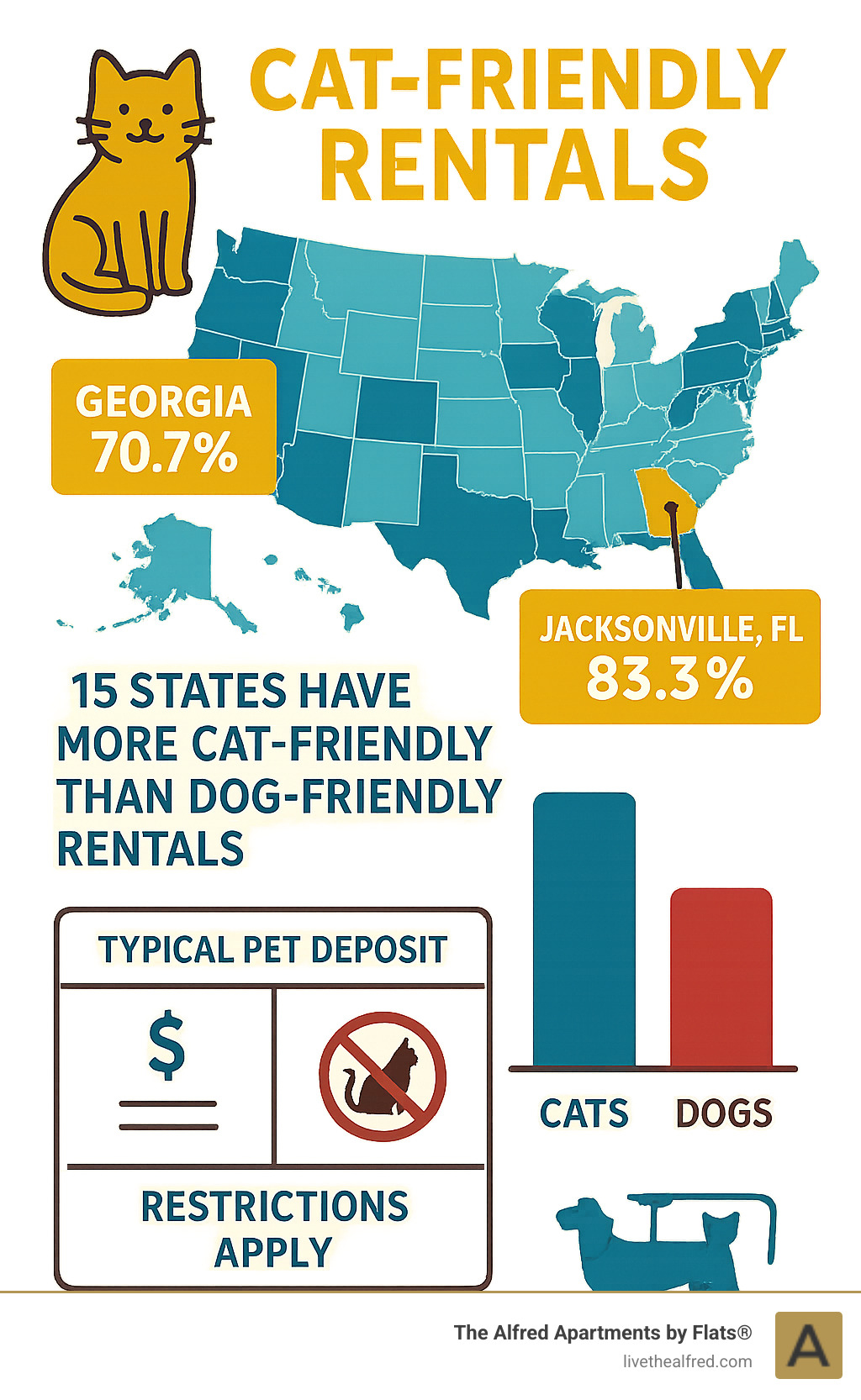
What Makes a Cat-Friendly Rental Different from "Pet-Friendly"
When you're scrolling through rental listings, you'll often spot the term "pet-friendly" – but don't be fooled. This broad label doesn't automatically mean the property is truly welcoming to your feline friend. Understanding the difference between generally pet-tolerant and genuinely cat friendly rentals can save you considerable headaches during your housing search.
A truly cat friendly rental goes beyond simply allowing cats through the door. These properties have thoughtfully considered the unique needs of feline residents and their humans. Let's explore what sets them apart:
Specific Cat Policies
Cat-specific rental policies acknowledge that cats aren't just small dogs. They recognize the unique considerations that come with feline residents:
Most cat friendly rentals will have clear guidelines about litter box placement – typically requiring them to stay on hard surfaces rather than carpeting. They might also outline expectations for cleaning frequency to maintain a fresh-smelling home.
Unlike dog damage (which tends to involve chewing and accidents), cat-related concerns primarily revolve around scratching. Forward-thinking landlords understand this distinction and may structure their deposit requirements accordingly.
Many properties limit residents to one or two cats per unit, regardless of size. This differs from dog policies that often focus on weight or breed restrictions. And while exotic breeds or hybrids might occasionally face limitations, domestic cats rarely encounter breed discrimination.
Progressive cat friendly rentals are increasingly taking a stand against declawing, with some explicitly prohibiting this practice in their lease agreements. This reflects growing awareness that declawing is considered inhumane by many veterinarians and animal welfare organizations.
Key Features Landlords Look For
Property owners who welcome cats typically invest in features that create harmonious living environments:
Scratch-resistant flooring tops the list of cat-friendly features. Materials like luxury vinyl, ceramic tile, or certain hardwoods can withstand the occasional scratch while still looking beautiful. These practical surfaces also make litter box accidents easier to clean.
Safety features are equally important. Enclosed balconies with secure screening allow cats to enjoy fresh air without risk of falls or escapes. Similarly, window screens must be sturdy enough to prevent determined cats from pushing through them during bird-watching sessions.
Good ventilation systems help minimize odor concerns – a priority for both cat owners and their neighbors. Some higher-end properties even incorporate dedicated pet areas with built-in climbing shelves or sunny window perches.
Behind the scenes, landlords of cat friendly rentals typically ensure their property insurance covers cat-related incidents, providing peace of mind for everyone involved.
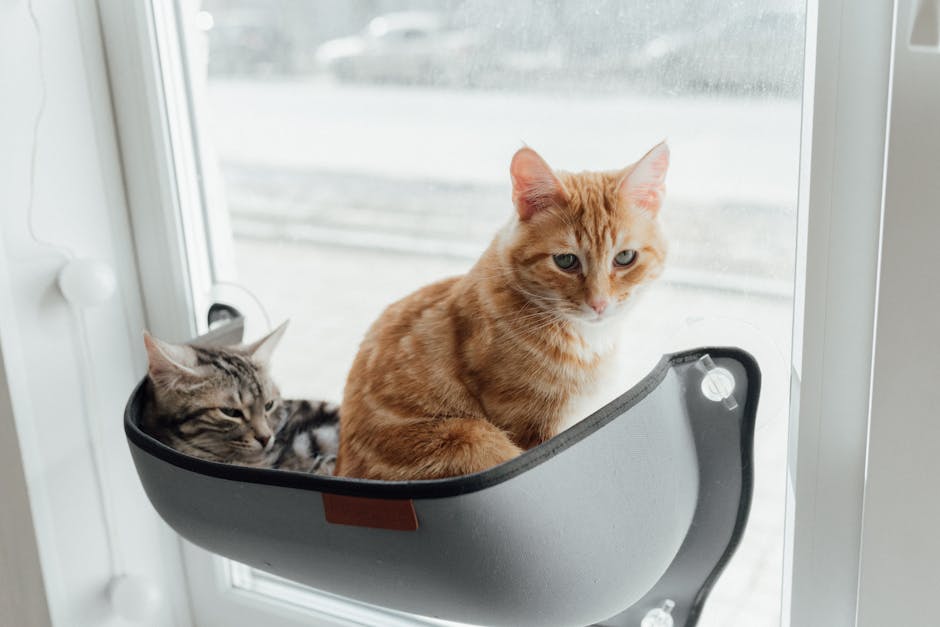
At The Alfred Apartments in downtown Chicago, we understand these distinctions perfectly. Our spaces blend historic architectural charm with thoughtful, pet-friendly practicality. We've carefully preserved beautiful details while incorporating contemporary conveniences that create comfortable homes for both you and your feline companion.
Cat Friendly Rentals: U.S. Hotspots & Key Stats
Looking for a feline-friendly place to call home? Where you search can make all the difference. Across America, some regions roll out the welcome mat for cats while others... not so much.
Georgia stands out as the cat lover's paradise, with a remarkable 70.7% of rentals welcoming furry feline residents. This southern state leads the nation in cat acceptance, making your apartment hunt significantly easier if you're relocating there with your whiskered companion.
City-wise, Jacksonville, Florida takes the crown with an impressive 83.3% of rental properties allowing cats. If warm weather and cat-friendly living sound appealing, Jacksonville might be your perfect destination.
The Lone Star State deserves special mention too – Texas boasts three cities in the top ten cat-accepting metropolitan areas, creating a trifecta of opportunity for cat owners looking to relocate.
Regional patterns tell an interesting story as well. The Northeast region consistently shows a stronger preference for cats over dogs compared to other parts of the country. This cat-friendly attitude might reflect the more compact living spaces and urban lifestyle common in northeastern states.
Where Are Cats More Welcome Than Dogs?
Surprisingly, cats only have the rental advantage in 15 states nationwide. What explains this feline favoritism in these locations? Several factors come into play:
The urban density factor makes a significant difference. In more crowded cities with smaller living spaces, cats' indoor lifestyle and compact needs make them ideal apartment companions. They don't need outdoor walks and typically require less space than many dogs.
Lifestyle fit also influences these patterns. Areas with higher concentrations of young professionals, singles, and busy urbanites tend to favor cats, whose independent nature suits city living.
Rental size trends further explain the pattern – regions dominated by smaller apartments naturally favor smaller pets who need less room to roam.
Madison, Wisconsin presents a fascinating case study in cat-friendly living. The city shows notably higher acceptance rates for cats than for similarly-sized dogs. Interestingly, Madison also reveals a compliance gap – only about 3% of cats are licensed compared to 30% of dogs. This highlights how differently cat ownership is tracked and regulated compared to dog ownership.
For those considering Chicago, The Alfred Apartments offers a welcoming environment for cat owners in The Loop. Our thoughtfully restored historic architecture accommodates modern living needs, including those of discerning pet parents seeking quality housing in downtown Chicago.
According to scientific research on allergy impact, cat allergies are more common than dog allergies, which might influence some landlords' policies. However, with proper cleaning and maintenance, most buildings can comfortably accommodate cats without allergy concerns.
Finding & Applying for Cat Friendly Rentals
The hunt for cat friendly rentals doesn't have to feel like searching for a needle in a haystack. With the right approach and a bit of preparation, you can find the perfect home for both you and your feline companion.
Effective Search Methods
Finding a welcoming space for you and your cat starts with knowing where to look. Specialized rental platforms like Zillow, Apartment List, and RentCafé offer pet-specific filters that can save you hours of scrolling. On Zillow, make sure to select "cats allowed" rather than the broader "pets allowed" option to narrow your results to truly cat-friendly options.
Don't overlook local humane societies and animal shelters as valuable resources. Many maintain updated lists of pet-friendly housing options and can offer advice specific to your area. These organizations often have relationships with cat-friendly landlords who have proven track records of accommodating feline residents.
Owner-managed properties frequently offer more flexibility than corporate-managed complexes. Individual landlords can make case-by-case decisions about your specific cat, rather than following rigid company-wide policies. When browsing listings, pay special attention to those that specifically mention cats—these landlords have likely already considered what it means to welcome feline residents.
Here in Chicago's Loop, historic buildings like The Alfred Apartments often strike that perfect balance between architectural character and pet-friendly living. Our restored spaces provide unique environments where both you and your cat can feel at home among historic details and modern conveniences.

Improving Your Chances in Cat Friendly Rentals
Once you've found promising options, it's time to present yourself as the ideal cat-owning tenant. Being proactive about addressing landlord concerns can significantly boost your approval odds.
Demonstrate financial responsibility by offering a slightly higher security deposit. This shows you're prepared to take responsibility for any potential issues while giving the landlord additional peace of mind. Similarly, having renters insurance with pet liability coverage can make landlords feel more secure.
Share your cat's history through vet records showing regular checkups and vaccinations. Letters from previous landlords confirming your cat caused no damage or disturbances carry tremendous weight. If you work from home, highlight this benefit—remote workers provide more supervision for their pets, reducing the likelihood of problems.
Sometimes, arranging a meet-and-greet can work wonders. Well-behaved cats often sell themselves better than any application ever could. A clean, friendly cat can instantly dispel common landlord concerns about odors or property damage.
The pandemic has actually improved some landlords' perspectives on cats. With more people working remotely, cats have proven to be ideal companions that don't require midday walks or constant attention, making them particularly well-suited to apartment living.
Crafting a Stand-Out Pet Resume
A professional pet resume might sound unusual, but it can be your secret weapon in securing a cat friendly rental. This document presents your cat as the well-cared-for, responsible resident they are.
Include a flattering photo of your cat alongside basic information like name, age, and breed description. Document their health status with vaccination records, spay/neuter certification, and microchip details. A brief temperament description highlighting positive traits like "quiet," "gentle," or "well-socialized" helps landlords envision your cat as a good neighbor.
Reference ideas that strengthen your application include statements from veterinarians, former landlords, pet sitters, neighbors, and groomers. Each of these provides a different perspective on your cat's behavior and your responsibility as an owner.
At The Alfred Apartments, we appreciate residents who take this thoughtful approach to their applications. It demonstrates not just your love for your pet, but your understanding of what it means to be part of a community where pets and people coexist harmoniously. For more information about our application process, visit our FAQs page.
Moving In & Living Responsibly With Your Cat
Transitioning to your new cat friendly rental is an exciting milestone for both you and your feline companion. Creating a harmonious living situation takes a bit of preparation and ongoing care, but the effort pays off in a happy home life and positive landlord relationship.
Setting Up Your New Space
Before your cat takes their first curious steps into your new apartment, take time to create a welcoming environment. Start by cat-proofing the basics—secure dangling cords, remove toxic plants, and check for any small spaces where an inquisitive cat might get stuck but can't easily escape.
Most cats feel overwhelmed by a complete environment change, so designate one room as a "safe haven" with familiar items from your previous home. Place their favorite bed, toys, food, water, and litter box in this space, allowing them to adjust gradually before exploring the entire apartment.
Strategic scratching post placement is perhaps your most important defense against damage to your cat friendly rental. Position posts near furniture your cat might otherwise target, particularly near corners and high-traffic areas. The right scratching options protect your security deposit while satisfying your cat's natural instincts.
Litter box location deserves careful thought too. Seek spots offering privacy for your cat but convenience for you—bathroom corners, laundry areas, or closets with the door propped open work well. In smaller apartments like those at The Alfred, utilizing bathroom space often makes the most sense while keeping odors contained.
Cats naturally appreciate vertical territory, so create climbing opportunities that won't damage walls. Free-standing cat trees, window perches with strong suction cups, and sturdy shelving designed for cats help satisfy their instinct to survey their domain from above.
Don't forget to secure windows and balconies before your cat starts exploring. Even well-behaved indoor cats can be tempted by an open window or balcony edge. Check that all screens are firmly attached and consider childproof locks for windows that open wide.
Maintaining Good Relations
Being a model tenant with a cat requires ongoing attention to a few key areas. Noise management tops the list—if your cat develops nighttime vocalization habits, consult your veterinarian promptly. What seems like annoying behavior often signals an underlying health concern that needs addressing.
Odor control ranks equally high on landlord concerns. Daily litter box scooping, weekly complete changes, and quality odor-neutralizing products help maintain a fresh-smelling apartment. Good ventilation makes a tremendous difference too—open windows when weather permits or use air purifiers during extreme seasons.
Regular grooming reduces the amount of hair and dander that accumulates in carpets and upholstery. Even short-haired cats benefit from weekly brushing sessions, which can prevent excessive shedding while strengthening your bond with your pet.
Building positive relationships with neighbors helps prevent complaints before they happen. A friendly note introducing your cat or a casual conversation mentioning your pet can open communication channels. Address any concerns neighbors raise immediately and with genuine consideration.
Honesty about any property damage serves you better in the long run. If your cat damages something despite your best prevention efforts, inform management promptly rather than attempting repairs yourself or hoping no one notices. Most landlords appreciate transparency and will work with responsible tenants.
Keep your cat's vaccination records organized and accessible. Many cat friendly rentals require annual verification of vaccinations, and having these documents readily available demonstrates your commitment to responsible pet ownership.
Finally, develop an emergency plan before you need it. Locate the nearest 24-hour veterinary clinic, save their number in your phone, and identify a trusted friend who could pet-sit on short notice. At The Alfred Apartments, our downtown Chicago location offers convenient access to several excellent veterinary practices within a short distance.

Frequently Asked Questions About Cat Friendly Rentals
Cat Friendly Rentals: Will I Always Pay a Pet Deposit?
When it comes to cat friendly rentals, the question of deposits and fees is often top of mind for pet parents. The short answer? You'll likely need to budget for some type of pet-related payment, though what that looks like can vary widely.
Most property managers require financial security when welcoming feline residents. These typically range from $200-$500 per cat, with the amount often reflecting the quality of finishes in the apartment. In luxury buildings with high-end features (like those you'll find in downtown Chicago), these deposits might trend toward the higher end of the spectrum.
The structure of these payments falls into a few common categories. Some landlords prefer a refundable security deposit that you'll get back if your cat doesn't damage the property. Others charge a non-refundable pet fee (usually $100-$300) that covers expected wear and tear. And increasingly common is the monthly "pet rent" approach—an extra $25-$50 added to your monthly payment for each cat.
Many properties mix and match these options. You might pay both an upfront deposit and continue with monthly pet rent throughout your lease. This is perfectly normal, though it's always worth clarifying exactly what each payment covers before signing anything.
Can Landlords Legally Refuse My Emotional Support Cat?
The world of emotional support animals and housing rights can be confusing to steer. If your cat provides essential emotional support for a documented disability, they may qualify for special considerations under the Fair Housing Act.
For your cat to be recognized as an emotional support animal (ESA) rather than a pet, you'll need proper documentation from a licensed healthcare provider confirming both your disability and how the cat alleviates your symptoms. With this documentation, landlords typically must:
- Make exceptions to no-pet policies
- Waive standard pet deposits and fees
- Provide reasonable accommodations for your ESA
However, not all properties fall under these requirements. Smaller buildings (four or fewer units) where the owner lives on-site are exempt, as are single-family homes rented without a real estate broker. Additionally, if your cat would pose a direct threat to others or create an undue financial burden for the property, exceptions may apply.
At The Alfred Apartments, we recognize the vital role emotional support animals play in many residents' lives and work compassionately with tenants who have legitimate needs while maintaining community standards.
How Many Cats Can I Keep in One Rental?
"How many is too many?" is a question with several answers when it comes to cat friendly rentals. Most commonly, landlords cap the feline population at 1-2 cats per apartment, though policies vary widely.
Several factors influence these limits. Building-specific considerations like ventilation systems or historic preservation requirements (particularly relevant in classic Chicago architecture) might restrict the number of pets allowed. Local ordinances may impose their own caps regardless of what your landlord permits.
There's also the ethical consideration of space—animal welfare experts suggest each cat needs at least 18 square feet of dedicated space to thrive. In smaller urban apartments, this naturally limits how many cats can comfortably coexist.
When multiple cats are allowed, expect additional financial considerations. Many properties charge an extra deposit or fee for each cat beyond your first feline, reflecting the increased potential for wear and tear. Some landlords may also request proof that your cats get along well together, especially in smaller living spaces.
At The Alfred Apartments, our pet policies balance respect for our historic Chicago buildings with the desires of responsible pet owners seeking quality housing in The Loop. We understand that your cats are family members, and we aim to create homes where everyone—human and feline alike—can live comfortably.
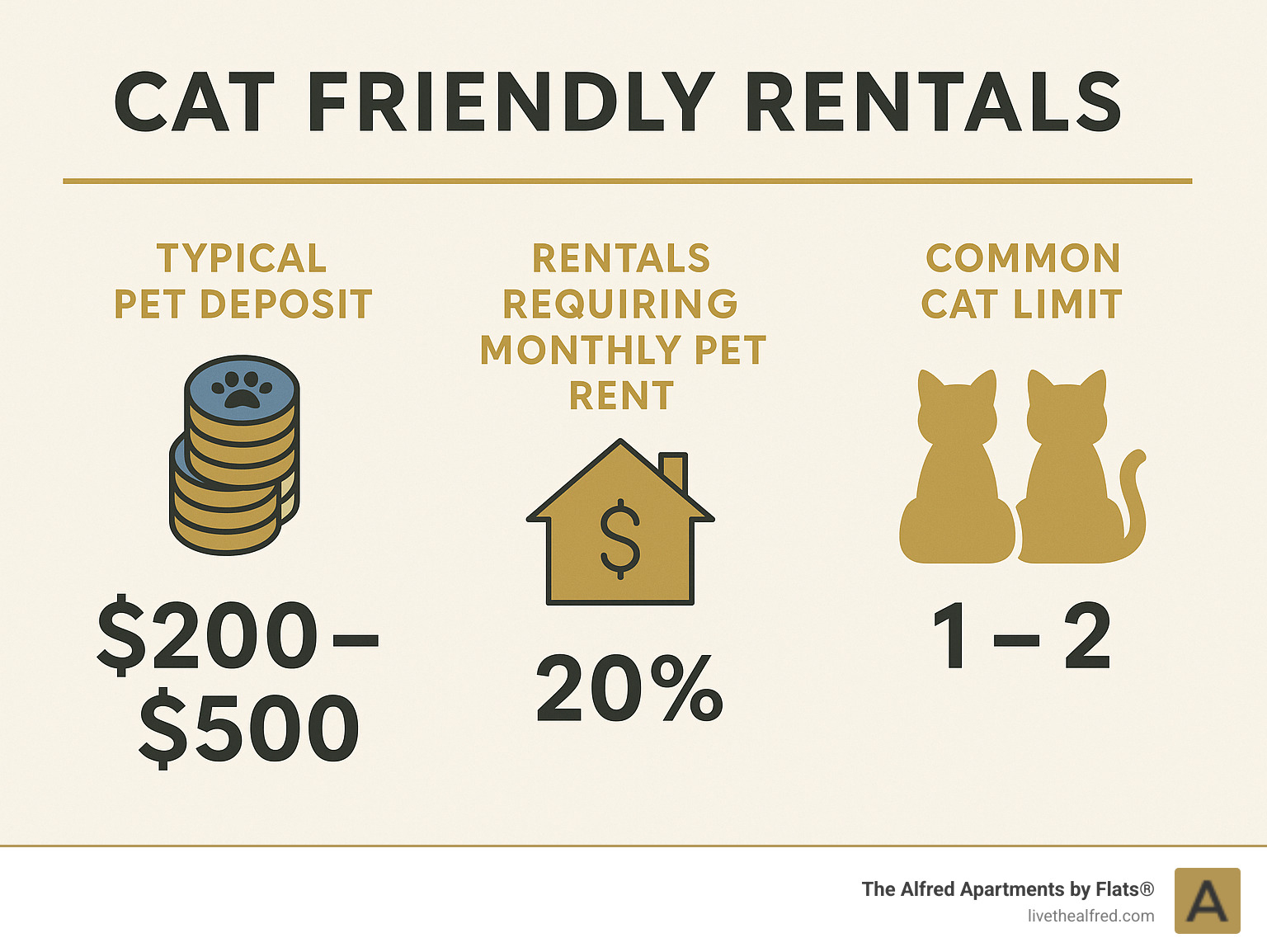
Conclusion
Finding cat friendly rentals feels much more manageable when you approach your search with the right knowledge and preparation. Throughout this guide, we've seen that understanding what truly makes a rental cat-friendly, knowing which locations welcome feline residents, and positioning yourself as a responsible pet owner can dramatically expand your housing options.
The journey to finding your perfect cat-friendly home comes with valuable insights worth remembering. The Northeast region and Georgia consistently offer more cat-friendly options than other parts of the country. Creating a professional pet resume significantly improves your chances of approval, while thoughtfully setting up your new space ensures both you and your landlord have a positive rental experience. Understanding the ins and outs of pet deposits, emotional support animal regulations, and typical cat number limitations helps you steer rental agreements with confidence.
For those drawn to the vibrant energy of downtown Chicago, The Alfred Apartments by Flats® offers the ideal blend of historic charm and modern convenience. Our thoughtfully restored buildings in The Loop create the perfect backdrop for urban cat owners seeking quality housing that welcomes their feline family members.
We understand that cats aren't just pets—they're cherished companions and important members of your household. That's why we've created living spaces that honor both the architectural heritage of our buildings and the needs of today's residents, including those with cats. Our commitment to preserving historic details while providing contemporary conveniences means you don't have to choose between character and comfort.
Whether you're moving across the country or just across town, the perfect cat-friendly home awaits you. With the right approach and resources, you and your feline friend will soon settle into a space where you both feel truly welcome.
Ready to explore pet-friendly living in downtown Chicago? Learn more about our amenities and how we accommodate pet owners in our historic Loop location.





